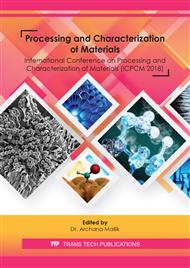[1]
B. Vijaya Ramnath, V. M. Manickavasagam, C. Elanchezhian, C. Vinodh Krishna, S. Karthik, and K. Saravanan, Determination of mechanical properties of intra-layer abaca–jute–glass fiber reinforced composite, Mater. Des., 60 (2014) 643–652.
DOI: 10.1016/j.matdes.2014.03.061
Google Scholar
[2]
A. Kumar Sinha, H. K. Narang, and S. Bhattacharya, Evaluation of Bending Strength of Abaca Reinforced Polymer Composites, Materials Today: Proceedings, 5 (2018) 7284-7288.
DOI: 10.1016/j.matpr.2017.11.396
Google Scholar
[3]
R. Mahjoub, J. M. Yatim, A. R. Mohd Sam, and M. Raftari, Characteristics of continuous unidirectional kenaf fiber reinforced epoxy composites, Mater. Des., 64 (2014) 640–649.
DOI: 10.1016/j.matdes.2014.08.010
Google Scholar
[4]
S. M. Suresh Kumar, D. Duraibabu, and K. Subramanian, Studies on mechanical, thermal and dynamic mechanical properties of untreated (raw) and treated coconut sheath fiber reinforced epoxy composites, Mater. Des., 59 (2014) 63–69.
DOI: 10.1016/j.matdes.2014.02.013
Google Scholar
[5]
A. K. Bledzki, A. Jaszkiewicz, and D. Scherzer, Mechanical properties of PLA composites with man-made cellulose and abaca fibres, Compos. Part A Appl. Sci. Manuf., 40 (2009) 404–412.
DOI: 10.1016/j.compositesa.2009.01.002
Google Scholar
[6]
B. V. Ramnath, S. J. Kokan, R. N. Raja, R. Sathyanarayanan, C. Elanchezhian, A. R. Prasad, and V. M. Manickavasagam, Evaluation of mechanical properties of abaca – jute – glass fibre reinforced epoxy composite, 51 (2013) 357–366.
DOI: 10.1016/j.matdes.2013.03.102
Google Scholar
[7]
H. M. Akil, C. Santulli, F. Sarasini, J. Tirillo, and T. Valente, Environmental effects on the mechanical behaviour of pultruded jute/glass fibre-reinforced polyester hybrid composites, Compos. Sci. Technol., 94 (2014) 62–70.
DOI: 10.1016/j.compscitech.2014.01.017
Google Scholar
[8]
A. K. Sinha, H. K. Narang, and S. Bhattacharya, Mechanical properties of natural fibre polymer composites, J. Polym. Eng., 37 (2017) 879-895.
DOI: 10.1515/polyeng-2016-0362
Google Scholar
[9]
M. R. Rahman, M. M. Huque, M. N. Islam, and M. Hasan, Mechanical properties of polypropylene composites reinforced with chemically treated abaca, Compos. Part A Appl. Sci. Manuf., 40 (2009) 511–517.
DOI: 10.1016/j.compositesa.2009.01.013
Google Scholar
[10]
A. K. Bledzki, A. A. Mamun, A. Jaszkiewicz, and K. Erdmann, Polypropylene composites with enzyme modified abaca fibre, Compos. Sci. Technol., 70 (2010) 854–860.
DOI: 10.1016/j.compscitech.2010.02.003
Google Scholar
[11]
M. Cai, H. Takagi, A. N. Nakagaito, Y. Li, and G. I. N. Waterhouse, Composites : Part A Effect of alkali treatment on interfacial bonding in abaca fiber-reinforced composites, Compos. Part A, 90 (2016) 589–597.
DOI: 10.1016/j.compositesa.2016.08.025
Google Scholar
[12]
F. Iucolano, D. Caputo, F. Leboffe, and B. Liguori, Mechanical behavior of plaster reinforced with abaca fibers, Constr. Build. Mater., 99 (2015) 184–191.
DOI: 10.1016/j.conbuildmat.2015.09.020
Google Scholar
[13]
M. Jacob, K. T. Varughese, and S. Thomas, Water sorption studies of hybrid biofiber-reinforced natural rubber biocomposites, Biomacromolecules, 6 (2005) 2969–2979.
DOI: 10.1021/bm050278p
Google Scholar
[14]
J. Gassan and A. K. Bledzki, Alkali treatment of jute fibers: Relationship between structure and mechanical properties, J. Appl. Polym. Sci., 71 (1999) 623–629.
DOI: 10.1002/(sici)1097-4628(19990124)71:4<623::aid-app14>3.0.co;2-k
Google Scholar


